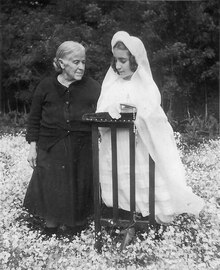
Back Pied-noir Afrikaans الأقدام السوداء Arabic Pied-Noir BCL Пие ноар Bulgarian Pieds-noirs Breton Pied-noir Catalan Černé nohy Czech Pied-noir Danish Pied-noir German Πιε-νουάρ Greek
A request that this article title be changed to Pied-noir is under discussion. Please do not move this article until the discussion is closed. |
 A First Communion in a Pied-Noir family in Sidi-Bel-Abbès, Colonial Algeria in the early twentieth century | |
| Total population | |
|---|---|
| 1959: 1.4 million[1] (13% of the population of Algeria) | |
| Regions with significant populations | |
| Algiers, Oran, Constantine | |
| Languages | |
| French, Spanish, Catalan, Occitan, Maghrebi Arabic | |
| Religion | |
| Predominantly: Christianity Minority: Judaism and Islam |
The Pieds-Noirs (French: [pje nwaʁ]; lit. 'Black Feet'; sg.: Pied-Noir) are an ethno-cultural group of people of French and other European descent who were born in Algeria during the period of French rule from 1830 to 1962. Many of them departed for mainland France during and after the war by which Algeria gained its independence in 1962.[3][4]
From the French invasion on 18 June 1830 to its independence, Algeria was administratively part of France; its ethnic European population were simply called Algerians or colons (colonists). But the Muslim people of Algeria were called Arabs, Muslims or indigènes. The term Pied-Noir came into common use shortly before the end of the Algerian War in 1962.
As of the last census in French-ruled Algeria, taken on 1 June 1960, there were 1,050,000 non-Muslim civilians (mostly Catholic, but including 130,000 Algerian Jews), some 10 per cent of the population.[5]
During the Algerian War, a vast majority of Pieds-Noirs were loyalists and overwhelmingly supported colonial French rule in Algeria. They were opposed to Algerian nationalist groups such as the Front de libération nationale (English: National Liberation Front) (FLN) and Mouvement national algérien (English: Algerian National Movement) (MNA). The roots of the conflict lay in political and economic inequalities perceived as an "alienation" from the French rule as well as a demand for a leading position for the Berber, Arab and Islamic cultures and rules existing before the French conquest. The conflict contributed to the fall of the French Fourth Republic and the exodus of European and Jewish Algerians to France.[4][6]
After Algeria became independent in 1962, about 800,000 Pieds-Noirs of French nationality evacuated to mainland France, while about 200,000 remained in Algeria. Of the latter, there were still about 100,000 in 1965, about 50,000 by the end of the 1960s and 30,000 in 1993.[7] During the Algerian Civil War between 1992 and 2002, the population of Pieds-Noirs and others of European descent plummeted, as they were often targeted by Islamist rebel groups. The French Consulate in Algiers recorded that around 300 persons of European descent remain in the country, whereas an Algerian census company recorded the number as higher.[8] The Pieds-Noirs who have remained since independence, are now overwhelmingly elderly.[9]
Those who moved to France suffered ostracism from some left-wing political movements for their perceived exploitation of native Muslims, while others blamed them for the war and thus for the political turmoil surrounding the collapse of the Fourth Republic.[4] In popular culture, the community is often represented as feeling removed from French culture while longing for Algeria.[4][6] The recent history of the Pieds-Noirs has been characterized by a sense of twofold alienation, on the one hand from the land of their birth and on the other from their adopted homeland. Though the term rapatriés d'Algérie implies that prior to Algeria they once lived in France, most Pieds-Noirs were born and raised in Algeria.
- ^ De Azevedo, Raimondo Cagiano (1994) Migration and development co-operation.. Council of Europe. p. 25. ISBN 92-871-2611-9.
- ^ Le vote pied-noir 50 ans après les accords d'Evian Archived 2015-11-20 at the Wayback Machine, Sciences Po, January 2012
- ^ Cite error: The named reference
OEDwas invoked but never defined (see the help page). - ^ a b c d Cite error: The named reference
Naylorwas invoked but never defined (see the help page). - ^ Cook, Bernard A. (2001). Europe since 1945: an encyclopedia. New York: Garland. pp. 398. ISBN 978-0-8153-4057-7.
- ^ a b Smith, Andrea L. (2006). Colonial Memory And Postcolonial Europe: Maltese Settlers in Algeria And France. Indiana University Press. pp. 4–37, 180. ISBN 978-0-253-21856-8.
- ^ "Pieds-noirs": ceux qui ont choisi de rester, La Dépêche du Midi, March 2012
- ^ Cite error: The named reference
diplo-sans-valisewas invoked but never defined (see the help page). - ^ "'In my heart': the Europeans who remain in Algeria, 60 years on". Retrieved 2023-02-19.
© MMXXIII Rich X Search. We shall prevail. All rights reserved. Rich X Search